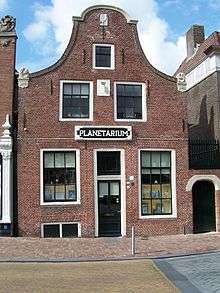Eisinga Planetarium
| Koninklijk Eise Eisinga Planetarium | |
 Front of the museum in 2007 | |
| Established | 1781 |
|---|---|
| Location | Franeker, Netherlands |
| Coordinates | 53°11′14″N 5°32′38″E / 53.187348°N 5.543965°E |
| Type | Science museum |
| Website |
www |
The Royal Eise Eisinga Planetarium (Dutch: Koninklijk Eise Eisinga Planetarium) is an 18th-century orrery in Franeker, Friesland, Netherlands. It is currently a museum and open to the public. The orrery has been on the top 100 Dutch heritage sites list since 1990 and in December 2011 was nominated as a UNESCO World Heritage Site candidate. It is the oldest working orrery in the world.
History
The orrery was built from 1774 to 1781 by Eise Eisinga.
It is listed as a Rijksmonument, number 15668.[1]
The orrery was nominated 12 December 2011 by the Dutch government for UNESCO World Heritage status, based on its long history as a working planetarium open to the public and its continued efforts to preserve its heritage.[2]
Orrery
An orrery is a planetarium, a working model of the solar system. The "face" of the model looks down from the ceiling of what used to be his living room, with most of the mechanical works in the space above the ceiling.[3] It is driven by a pendulum clock, which has 9 weights or ponds. The planets move around the model in real time, automatically. (A slight "re-setting" must be done by hand every four years to compensate for the February 29th of a leap year.) The planetarium includes a display for the current time and date. The plank that has the year numbers written on it has to be replaced every 22 years.
The Eise Eisinga Planetarium is the oldest still working planetarium in the world.
To create the gears for the model, 10,000 handmade nails were used.[4] In addition to the basic orrery, there are displays of the phase of the moon and other astronomical phenomena.
The orrery was constructed to a scale of 1:1,000,000,000,000 (1 millimetre: 1 million kilometres).[5]
References
- ↑ "kich.nl (Kennisinfrastructuur Cultuurhistorie)". Retrieved 2010-08-27.
- ↑ Nomination on tentative list at UNESCO website
- ↑ Sixma, H (November 1934). "The Franeker Planetarium". Popular Astronomy. SAO/NASA ADS. XLII (9): 489–495. Bibcode:1934PA.....42..489S. Retrieved 2011-06-22.
- ↑ "planetarium-friesland.nl". Retrieved 2010-08-27.
- ↑ "Eise Eisinga Planetarium (UNESCO)". Retrieved 2013-09-16.
External links
| Wikimedia Commons has media related to Eise Eisinga Planetarium, Franeker. |
- Official website
- Eisinga Planetarium at Atlas Obscura
- Eise Eisinga Planetarium at Jusonline.nl